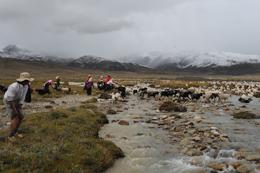In many regions, climate change has advanced the timing of spring events, such as flowering or the unfolding of leaves. But the meadows and steppes of the Tibetan Plateau are bucking that trend plants are starting to bloom later in spring, making the growing season shorter. This change could threaten the livelihood of the thousands of nomads who survive by raising cattle on the plateau.
 |
| The Tibetan Plateau is blooming later than it did 30 years ago. TAO Images Limited / Alamy |
"I've worked in the Tibetan Plateau region for 25 years," says Jianchu Xu, an ethnoecologist at the World Agroforestry Centre in Kunming, China, and a professor at the Kunming Institute of Botany of the Chinese Academy of Sciences, who led the study, published this week in the Proceedings of the National Academy of Sciences1.
Xu says he expected that plants on the plateau would follow the same pattern of early flowering seen elsewhere. In Europe, for instance, spring flowerings in 2000 occurred about 8 days earlier than they did in 1971 on average, and autumn events, such as changes in leaf colour, about 3 days earlier2.
"But then my PhD student Haiying Yu looked at more recent data" and discovered that the opposite was the case. The finding "contradicted the linear link" that is often seen between warming temperatures and an earlier start to the growing season, Xu says.
 |
| Land for grazing may be in short supply in future. (Image by XU Jianchu) |
The study showed an initial advance in the timing of the growing season or its 'phenology' for both the meadow and steppe for the first 15 years. But from 2000 until 2006 that trend was reversed. The net effect was a shortening of the growing season by about one month for steppe plants and three weeks for meadow vegetation.
Plants that have evolved in cold-weather climates become dormant in the winter to avoid frost damage. But the warmer winters on the plateau are delaying spring growth, the authors say, because plants are not meeting their chilling requirements a minimum period of time that plants must experience cold before they break winter dormancy.
"The idea has been out there, but I don't think very many people would have expected to see this sort of reverse response to warmer spring this soon," says Arthur Weis, an evolutionary biologist at the University of Toronto, Ontario.
Martin Lechowicz, a plant ecologist at McGill University in Montreal, Quebec is not surprised, however. Lechowicz and his colleagues have analysed and modelled the timing of leaf-bud burst in 22 North American tree species throughout the twenty-first century3. Almost all species showed earlier bud burst, but some had years of abnormal bud-burst timing because they had not chilled enough over the winter. "Many models of climate change's effects on the growing season don't deal with the internal climate-control system by which plants respond to seasonal temperature changes," says Lechowicz.
The Tibetan alpine meadow grassland is used by local people to graze their yaks and sheep. "The change in the growing season may mean there is less grassland biomass available for grazing," says Xu. "They will have to come up with local adaptive strategies to make sure the animals have enough grazing land."
"Although I'm not surprised, it is very interesting," says Lechowicz, But more detailed data would be useful, he says. "It would be nice to put people on the ground and have them do a species-by-species tracking. That would help resolve what is going on in the plant communities."
Xu says he has plans to study the reaction to warmer winter temperatures at the species level to understand the phenology changes in detail and perhaps suggest possible strategies for dealing with diminishing opportunities for nomads grazing their animals on the plateau.
References
Yu, H. et al. Proc Natl Acad. Sci. USA doi:10.1073/pnas.1012490107 (2010).
Menzel, A. et al. Glob. Change Biol. 12, 1969-1976 (2006).
Morin, X. et al. Glob. Change Biol. 15, 961-975 (2009).
Related News
Photos
More>>trade
market
finance
- Ma Wen Spoke at the National Videophone Conference on the Special Task of
- The Second Joint Conference of Corruption Prevention: Adhering to the guidance
- Conclusion Ceremony of the Workshop on Corruption Prevention of Asian and
- He Yong Stressed at the National Experience Exchange Conference of Deepening
- He Guoqiang Stressed at the First Session of the Joint Conference of Corruption





